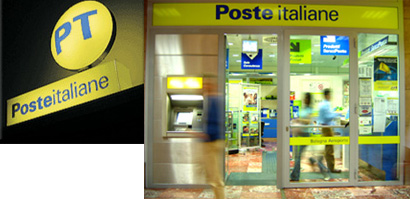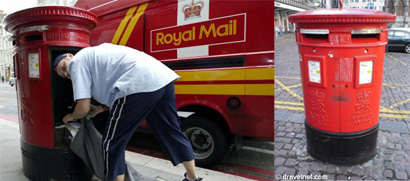I recently paid a visit to an Italian Post Office. I was sending some postcards to friends and family when I realized how drawn I found myself to this place—with its bright yellow, big glass windows and spare advertising (within the store).
The postal service is something that we all use, on a regular basis, no matter where we are. Yes, e-mail has spared us the daily visit, and the FedEx guy stopping by everyday has also reduced our interaction with the long lines in inevitably warm rooms but, in the end, we depend on it. So why not pay more attention to their design?
Let’s take a look at what is out there, on a regional basis:

NORTH AMERICA

Canada: Canada Post

With over 60,000 employees, Canada Post processed 11.1 billion pieces of mail in 2005.

2006 stamps.

United States of America: United States Postal Service

Free mail delivery in large cities began in 1863, but no official uniforms were worn until after July 27, 1868 (when Congress passed legislation authorizing use of uniforms by letter carriers).

2006 Stamps
Trivia: I thought you should know that in 2004 alone, 3,268 letter carriers were attacked by dogs. Please people, leash your puppies.

Mexico: Servicio Postal Mexicano

One of the first postal services in America, it was established in 1580, they currently employ 19,735 people across all areas.


SOUTH AMERICA

Brazil: Correios

Going beyond postal, it also provides internet access, banking (Banco Postal), and immediate forwarding (Sedex).


Argentina: Correo Argentino


Chile: Correos Chile



EUROPE

Italy: Poste Italiane

Approximately 14,000 post offices.

United Kingdom: Royal Mail


With 260 years of service, in March 2004, Royal Mail Group developed an independent charitable trust to manage the heritage of all Royal Mail, Post Office and Parcelforce Worldwide.



France: La Poste

They also operate in the French Overseas Departments of Réunion, Guadeloupe, Martinique and French Guiana, and the territorial collectivities of Saint Pierre and Miquelon and Mayotte-while their postage stamps are valid for use in the Overseas Departments, they are not in the Territorial Collectivities.


AFRICA AND THE MIDDLE EAST

Israel: Doar Israel

Less than forty-eight hours after the proclamation of the Independent State of Israel on Friday, May 14, 1948, enemy planes had launched their first attack and Israel had issued her first postage stamps.

Kenya: Posta Kenya


South Africa: SAPO, South African Post

Dealing with some eight million mail items to almost 6,5 million address-3,4 million of these are street addresses and three million are postboxes.

Iran: I.R.I Post Company


ASIA

Japan: Japan Post



China: China Post


“The logo of China Post combines the calligraphy of the Chinese character and the image of the postal network. Taking the look of wings, it can be associated with the ancient figuration for message exchange. Simple but vigorous, the logo is mainly made up of horizontal and vertical parallels, indicating the sense of order and far reaches. The right-leaning writing gives the sense of direction and speed. The logo of China Post implies that our target is to serve thousands of households and our image is to be rapid, accurate, safe and far reaching.”
China Post 2004 Annual Report


Singapore: SingPost

Singapore Post has a heritage dating back to the founding of Singapore by Sir Stamford Raffles in 1819. In those days, a single mail office collected and delivered the small volume of letters. It was located in the previous Parliament House and run by just three persons.



I can see that blue is not only the color of Corporate America, but of the entire postal service. As I searched for logos and images of this service I was amazed at the color palette. Don’t get me wrong, it makes sense, what with blue skies and safe colors, there is no better marriage than blue with a bright happy color such as red or yellow.
Nor was I surprised by the vast amount of “wings” across the world, although I am particularly fond of Kenya Post. It is softer, cuter and somewhat localized, which makes it a bit more special in my heart. Granted you want to be global as a postal service, but does that mean you need to lose your national identity? And look like everyone else?
In the end, I have to admit I am not impressed or smitten with any of the identities I randomly researched (other than the Italian one, which started it all). Why? Why don’t we pay more attention to a company that represents us on an international level, that connects us within our country and with those we love? One of the few institutions that deal on every area of a country, be it the largest city or the most remote village—always present, usually an eyesore.






Why don't we pay more attention to a company that represents us on an international level, that connects us within our country and with those we love?
Bryony, the same question could apply to our currency, a god-awful collection of greens on an old and weathered sheet of paper that's plastered with dead white men. But the answer lies at the top level: government. Has the government (specifically our's) ever been aesthetically concerned with its identity? Whether the post carriers, space program, currency, or government identity itself?
On Jun.23.2006 at 01:26 PM